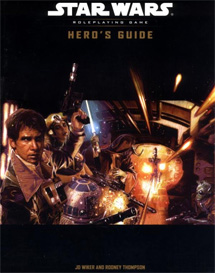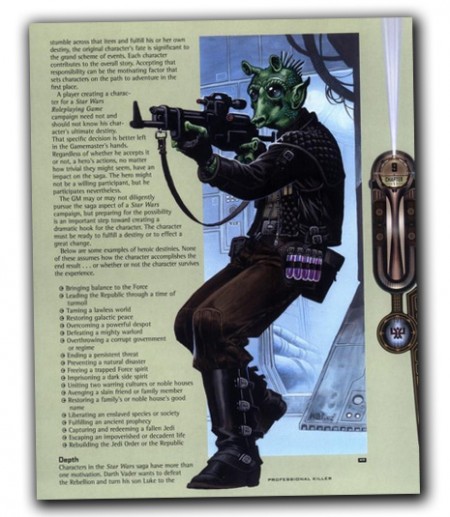Reading – Star Wars Hero’s Guide

NOTE: I wrote this review back in June of 2003, which makes this almost a decade old. Man, it’s sometimes scary to think about how long I’ve been writing about games.
The Star Wars Hero’s Guide*, for the Star Wars Roleplaying Game, is a 160-page hardcover book priced at $29.95. As with all of the newer releases for this line it is a full-color product packed with beautiful artwork and photos and is, as usual, a very attractive book to possess.

The book is designed as a companion to the main rules and features material from the Star Wars Gamer magazine (Amazon.com search*), the Wizards of the Coast website, and suggestions made by fans on various message boards. A quick glance at the table of contents shows that this book is definitely designed with players in mind. The book is broken into nine chapters, ranging from creating characters to droids. This review will address each chapter, highlighting what I consider to be the best content to be found within its pages.
Chapter One: Character Creation
This short chapter (six pages) covers “rule zero†(checking with your GM before creating a character), tips on assigning ability scores (which includes some excellent instructions on min-maxing characters and even explains what min-maxing is), and dramatic hooks. Dramatic hooks are the largest part of the chapter and intended to give players springboard ideas on which to design their character and background. This is broken into Saga, Depth, and Emotion, and does a good job of giving players dozens of different ideas for their character’s reason for being a part of the adventure.

Chapter Two: Character Archetypes
The concept of archetypes first appeared in Star Wars Gamer magazine (Amazon.com search*) and is another tool for customizing characters while using the core character classes. Archetypes are based around the idea of multiclassing and each archetype presented here tells the player exactly what class to choose at what level in order to take on such roles as Demagogue, Imperial Officer, Information Broker, Jedi Wanderer, and others. There are a total of eleven different archetypes in the book. The most interesting feature of archetypes is the “variant abilities†each archetype includes. These are new class features that may be selected instead of core class features. A an example, the Information Broker – an archetype that uses the Noble and Scoundrel core classes — may replace the noble’s resource access with Blackmail with which he squeezes others for money. It’s a simple system that adds depth similar to that found in prestige classes without actually using new classes.
Chapter Three: Skills and Feats
This is an expected chapter in all D20 books designed for characters and its inclusion here was no surprise. The chapter begins with a section on new tricks for old skills and then moves directly into new feats. The back cover text claims “Over 90 new feat . . . “ and without counting I can believe it. Most of the feats are very well designed and interesting, but leave me with the always-difficult choice of “how the hell do I choose just one feat?†Feats are the most exciting addition to the D&D rules and I love them but I sure do wish there was a way to get more of them for my characters. In addition to the usual types of feats there are also Martial Arts Feats and Lightsaber Form Feats. The seven Lightsaber Form Feats are fully described (many have illustrations or photos) and grant such abilities as:
Form II Mastery — +3 dodge bonus to Defense against lightsaber attacks.
Form IV Mastery – The character may add one and a half times his Dexterity bonus (instead of Strength) to damage when using a lightsaber one-handed or 2x if using it two-handed.
Only one lightsaber form feat may be used at a time. Maybe the next book will include a feat that lets the feats be mixed during battle.
Chapter Four: Prestige Classes
Just as all books must include a chapter with new feats they must also include new prestige classes. This chapter presents nine new prestige classes. They are Chief Engineer, Infiltrator, Loyal Protector, Martial Arts Master, Master Duelist, Outlaw Slicer, Priest, Sharpshooter, and Treasure Hunter.
Chapter Five: Factions
In my opinion, this chapter contains the book’s best new content. Factions require a new rule called Sympathy. Sympathy is a type of Reputation bonus that is only applied when dealing with a specific faction that you have Sympathy in (or a faction that opposes a faction you have Sympathy in). The Sympathy bonus stacks with your Reputation bonus and, at the end of each adventure in which you do something that the GM feels showed sympathy toward a particular faction, you gain a +1 to your Sympathy for that faction only. You keep track of Sympathy for each faction and the highest your score may go is +5. You lose Sympathy when you betray or neglect a faction. The Sympathy rules are short, well described, and easy to understand. It’s the actual faction descriptions where the real meat of the chapter can be found.
There are 14 different factions described in detail, each with new feats, a prestige class, or any number of other new rules. Not every faction has new prestige classes but they’re all interesting and really help add detail to a campaign. A few other factions are also described but these have a lot less detail. Rules on joining and quitting factions help the GM to base adventures around the various factions described in this chapter.
From here on the chapters start to get a bit short. This isn’t all that surprising since the Factions take about 1/3 of the book.

Chapter Six: Equipment
Rules for cybernetics and loans were what I found most interesting in this chapter. The loan rules, especially, were a nice touch. By going through a bank or loan shark a character may acquire a large sum of money, which he must begin, paying back, each payment due when the character gains a level. The payment amounts make it feel as if the rule was specifically written to force characters to miss payments but, as always, conflict means adventure. If it were easy to pay a loan back there would be no chance for excitement.
Chapter Seven: Combat
A host of new rules and clarifications fill this chapter. While useful, it isn’t exactly interesting. The rules covered include suppression fire, ion weapons, lightsaber deflection and throwing lightsabers, and a clarification of flanking.
Chapter Eight: The Force
New force techniques, alternate traditions, and prestige classes can be found in this chapter. A very short section on force spirits is also included and is the most interesting section of the chapter.
Chapter Nine: Droids
Droids as henchmen, training remotes, droid feats, and new droid prestige classes make up this chapter.
This is a great book for Star Wars players and is definitely a better choice for a player on limited funds than any of the other Star Wars RPG books. With the core rulebook and Hero’s Guide a player will have everything he could want for creating and playing Star Wars characters. Some rules, such as the factions, really help with creating the Star Wars feel during a game session. Others, like archetypes, are interesting but not as useful. I suspect that a book devoted to factions would do very well and be a great tool for GMs when it comes time to write adventures.

Related articles
- Yoda Lightsaber Chopsticks (neatorama.com)
- 101 Simple Archetypes from G*M*S Magazine (gmsmagazine.com)
